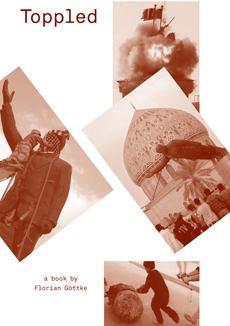Review: Toppled by Florian Göttke

I had Florian Göttke’s Toppled in my “to review” pile of books, when I came across Pete Brook’s post about it. Pete writes “The book is a concept. I understand the concept. And, the images are essentially props to the concept (illustrations of the new biographies of statues, of things).” That’s what I thought - until I read the text. Turns out Toppled is considerably more complex than that. (more)
It might be worthwhile to point out first that the images in the book were collected via the web. That in itself is hardly noteworthy - there are man people who “mine” the web for images. What is noteworthy is that Göttke does more than collecting images (there is a website) and then putting them into a widely known (or accepted) context: He does investigate what is behind the images, and he dives fairly deeply into the various aspects of the statues of the former Iraqi dictator. For example, the reader learns about the history of those statues and what some of the symbols mean. Lest we forget it, our own cities contain political statues, and while we probably think that have nothing to do with the Iraqi ones, after reading the book you might not be so certain any longer.
Göttke writes “I found myself on fascinating excursions into such fields as media analysis, iconology, art history, psychology, and addressing, amongst other issues, propaganda, political rituals, idolatry and iconoclasm.” That’s a lot more than just looking at the propaganda value of the tearing down of one statue. Whether you will find that interesting you need to decide for yourself; but I wager you will be surprised by some of what you’ll learn when reading Toppled.
It gets most fascinating when Göttke considers iconoclasm: “While the statues were still standing many people probably passed them without showing any respect or even noticing. But the intense emotions of the erupting attacks imbued them with a life of their own.” And a few sentences later, he writes “Maybe these kinds of idols only lose their power when they are denied their symbolic value, not when they are destroyed, but rather transformed and recontextualized. Perhaps when they are taken from their original arena […] and are transported into the aesthetic domain. When they are placed in the art museum instead of the military museum, they might actually lose their divisive political impact.” (my emphasis)
This is where the book delivers something that goes beyond the statues of Saddam Hussein, in that it asks us to consider our relationship with political icons, to think about how and why they retain their power - and, in particular, what role the context of art can play to deal with them.
Toppled, text by Florian Göttke, paperback, 148 pages, post editions, 2010